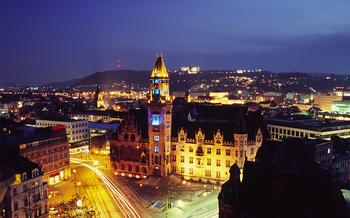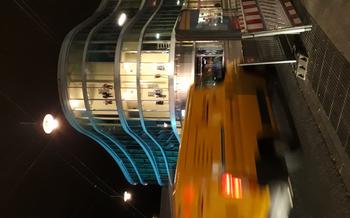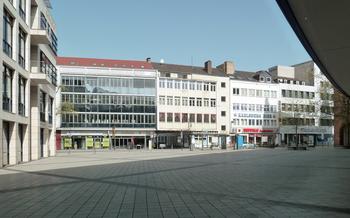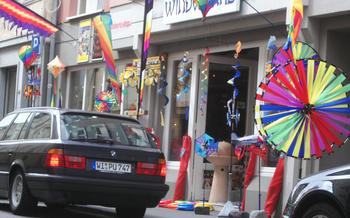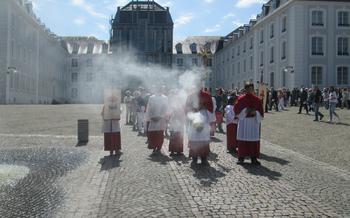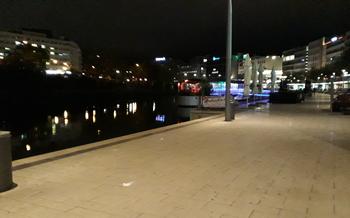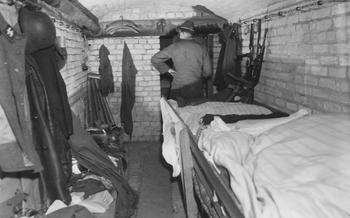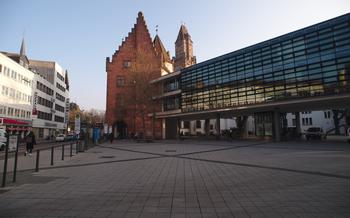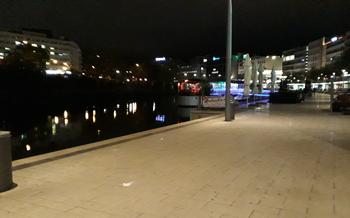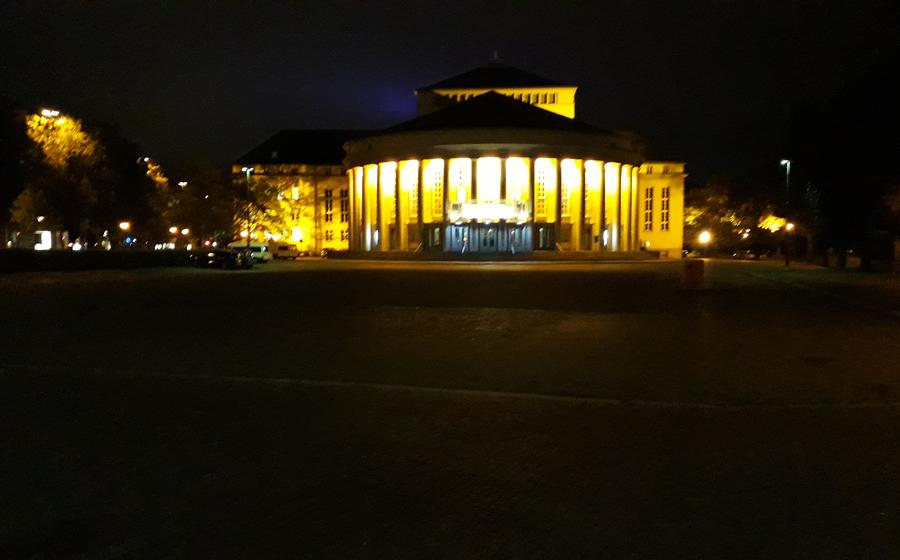
Saarbrücken Bismarckbrunnen
- Historical Significance:
- Design and Architecture
- Location and Setting
- The Sculptor: Fritz Schaper
- Inauguration and Unveiling
- Symbolism and Allegories
- The Fountain's Restoration:
- Local Traditions and Customs
- Bismarck's Legacy in Saarbrücken
- The Changing Political Landscape
- The Fountain's Cultural Significance
- Events and Activities
- Practical Tips for Visitors
- Educational Opportunities
- Insider Tip: Unveiling a Hidden Treasure
Historical Significance:
The Bismarckbrunnen in Saarbrücken stands as a testament to the monumental figure of Otto von Bismarck, the "Iron Chancellor" who played a pivotal role in shaping the destiny of Germany. Conceived in 1901, the fountain's construction was driven by a surge of national pride and the desire to honor Bismarck's contributions to German unification. The grand unveiling in 1904, attended by Kaiser Wilhelm II himself, marked a significant moment in the city's history, solidifying the Bismarckbrunnen's status as a symbol of German unity and national identity. Bismarck's legacy extends far beyond his time, and the fountain remains a poignant reminder of his enduring impact on Germany's historical trajectory, embodying the spirit of a nation forged through his vision and leadership.
Design and Architecture
The Bismarckbrunnen is a masterpiece of intricate design and symbolism. At its center stands the imposing figure of Otto von Bismarck, clad in military uniform and radiating an aura of authority. His right hand rests on his sword, while his left hand holds a document representing the German constitution. The surrounding allegorical sculptures further enhance the monument's significance. Four majestic eagles, representing the four German kingdoms of Prussia, Bavaria, Saxony, and Württemberg, soar above Bismarck's head, symbolizing the unity and strength of the newly formed empire.
At the base of the fountain, four female figures personify the virtues that Bismarck held dear: strength, justice, wisdom, and moderation. Strength is depicted as a muscular woman wielding a sword, Justice holds a set of scales, Wisdom is represented by an owl, and Moderation is symbolized by a woman pouring water from a jug. These allegorical figures add depth and meaning to the monument, reinforcing the values that Bismarck embodied and the ideals that shaped his leadership.
The Bismarckbrunnen is a testament to Fritz Schaper's artistic prowess and his ability to capture the essence of a historical figure through sculpture. The monument's intricate details and symbolic motifs make it a captivating work of art that continues to inspire awe and admiration.
Location and Setting
The Bismarckbrunnen stands majestically at the heart of Saarbrücken, on the Ludwigsplatz, a vibrant square teeming with life. The fountain's central position reflects its significance as a symbol of German unity and national pride. Its presence enhances the square's allure, making it a popular gathering place for locals and tourists alike.
To reach the fountain, visitors can conveniently take public transportation, with several bus and tram lines stopping nearby. Limited parking is available in the surrounding streets, but it's recommended to use public transportation or explore the city on foot to fully immerse oneself in the local atmosphere.
The area surrounding the Bismarckbrunnen is a treasure trove of attractions. The Saarland Museum, housed in a magnificent Baroque palace, is just a stone's throw away, showcasing the region's rich history, art, and culture. The vibrant pedestrian zone, with its charming boutiques, cafes, and restaurants, invites visitors to linger and soak up the city's ambiance.
The fountain's proximity to the Saar River adds to its allure. Visitors can take a leisurely stroll along the riverbanks, admiring the picturesque scenery and enjoying the tranquility of nature. The Bismarckbrunnen serves as a gateway to exploring the city's many other historical landmarks, including the Saarbrücken Castle, the Old Town Hall, and the Saarland State Theater.
The Sculptor: Fritz Schaper
Fritz Schaper, a renowned German sculptor, was entrusted with the creation of the Bismarckbrunnen. Born in 1841, Schaper studied under the renowned sculptor Rudolf Siemering in Berlin and quickly rose to prominence for his mastery of neoclassical and allegorical styles. His works are characterized by their intricate details, expressive figures, and symbolic narratives.
Schaper's artistic approach to the Bismarckbrunnen is evident in the fountain's elaborate design and allegorical representations. The central figure of Bismarck, depicted with a commanding presence and intricate facial features, captures the essence of the Iron Chancellor's strength and determination. The surrounding allegorical figures, symbolizing German virtues and values, further enhance the monument's narrative and convey a powerful message of unity and national pride.
Beyond the Bismarckbrunnen, Schaper's artistic legacy includes numerous notable works, such as the Goethe-Schiller Monument in Weimar, the Grand Duke Friedrich I Monument in Karlsruhe, and the Kaiser Wilhelm I Monument in Wiesbaden. His contributions to German sculpture earned him widespread recognition and accolades during his lifetime, and his works continue to be celebrated for their artistic merit and historical significance.
Inauguration and Unveiling
On a glorious day in 1904, the city of Saarbrücken witnessed a grand spectacle as the Bismarckbrunnen was unveiled to the public. The inauguration ceremony was graced by the presence of Kaiser Wilhelm II, the German Emperor, who traveled to Saarbrücken to honor the occasion. Accompanied by an entourage of dignitaries, including government officials and military leaders, the Kaiser arrived amidst cheering crowds and fanfare.
As the unveiling moment approached, a palpable sense of excitement filled the air. The fountain, covered in a large drape, stood shrouded in mystery, awaiting its grand reveal. With a flourish, the drape was pulled away, and the magnificent Bismarckbrunnen was unveiled to the world. The crowd erupted into applause and cheers, marveling at the intricate details and imposing stature of the monument.
Kaiser Wilhelm II, standing before the fountain, delivered a stirring speech, paying tribute to Otto von Bismarck's legacy and his pivotal role in shaping Germany's destiny. The event marked a significant milestone in Saarbrücken's history, solidifying the city's connection to the national narrative of German unification and honoring the memory of its most revered statesman.
Symbolism and Allegories
The Bismarckbrunnen is adorned with a wealth of symbolism and allegories that convey powerful messages about German unity and national pride. The four majestic eagles perched atop the fountain represent the four German kingdoms that were unified under Bismarck's leadership: Prussia, Bavaria, Saxony, and Württemberg. These eagles symbolize strength, power, and the collective spirit of the German nation.
The fountain also features several female figures representing German virtues. One figure, known as Germania, personifies the German nation itself. She is depicted as a strong and dignified woman, holding a sword and a shield, symbolizing the nation's strength and readiness to defend itself. Another figure, known as Justitia, represents justice and is depicted with a blindfold and scales, symbolizing impartiality and fairness.
The Bismarckbrunnen's symbolism extends to its intricate details. The fountain's base is adorned with reliefs depicting scenes from German history, including the Battle of Sedan, which marked the end of the Franco-Prussian War and the unification of Germany. These reliefs serve as a reminder of the nation's struggles and triumphs, and the role that Bismarck played in shaping its destiny.
The Bismarckbrunnen's symbolism and allegories combine to create a powerful visual narrative that celebrates German unity, national pride, and the legacy of Otto von Bismarck, the Iron Chancellor who forged a nation out of divided states.
The Fountain's Restoration:
The Bismarckbrunnen has undergone several restoration and renovation efforts over the years to preserve its original design and materials. One of the most significant restorations took place in the 1980s when the fountain was dismantled and transported to a specialized workshop for extensive repairs. The bronze sculptures were carefully cleaned and treated to remove corrosion and restore their original luster. The fountain's stone base and surrounding landscaping were also renovated to match their original appearance.
During the restoration process, workers discovered several interesting artifacts and historical inscriptions hidden within the fountain's structure. These included coins, documents, and even a time capsule that had been buried beneath the fountain's foundation. The time capsule contained letters, photographs, and other mementos from the time of the fountain's original construction, providing valuable insights into the history and significance of the monument.
The restored Bismarckbrunnen was unveiled to the public in 1989, marking a new chapter in its history. Since then, the fountain has continued to receive regular maintenance and upkeep to ensure its preservation for future generations.
Local Traditions and Customs
The Bismarckbrunnen has become an integral part of Saarbrücken's local traditions and customs. The fountain serves as a gathering place for various celebrations, protests, and public events. During the city's annual Saarbrücken Festival, the fountain becomes a focal point for festivities, with live music, performances, and food stalls filling the surrounding area.
On special occasions, such as national holidays or sporting victories, the fountain is often adorned with flags, banners, and colorful decorations, reflecting the community's pride and patriotism. It has also become a popular spot for political demonstrations and protests, where people gather to express their views and opinions on various issues.
One unique tradition associated with the Bismarckbrunnen is the "Bismarck Run." Every year, on a designated day, a group of runners dressed in historical costumes, reenact the arrival of Otto von Bismarck in Saarbrücken. The runners carry a torch and follow a route through the city, culminating at the fountain, where they are greeted by cheering crowds.
These local traditions and customs add to the significance of the Bismarckbrunnen, transforming it from a mere monument into a living symbol of Saarbrücken's history, culture, and community spirit.
Bismarck's Legacy in Saarbrücken
Otto von Bismarck's influence on Saarbrücken extends beyond the Bismarckbrunnen. His policies and leadership left a lasting impact on the city's development and identity. Bismarck's economic reforms, such as the introduction of the gold standard and the establishment of a unified currency, contributed to the growth and prosperity of the region. He also played a key role in the construction of the Saarbrücken-Trier railway line, which connected the city to other parts of Germany and facilitated trade and commerce.
Locally, Bismarck is remembered as a visionary leader who helped shape the modern German nation. His legacy is honored in Saarbrücken through various monuments, streets, and institutions named after him. The Bismarckturm, a 28-meter-high observation tower located on the Halberg hill, offers panoramic views of the city and the surrounding countryside. The Bismarckstraße, a major thoroughfare in Saarbrücken, is lined with historic buildings and landmarks. The Bismarck-Gymnasium, a renowned educational institution, carries on Bismarck's legacy of promoting academic excellence and civic engagement.
The people of Saarbrücken hold Bismarck in high regard for his contributions to German unification and his role in shaping the city's economic and cultural landscape. His legacy continues to inspire and motivate generations of Saarbrückeners, who strive to uphold the values of unity, progress, and national pride that he embodied.
The Changing Political Landscape
Throughout history, Saarbrücken has undergone significant political changes, and the Bismarckbrunnen has stood as a witness to these transformations. During the French occupation of Saarland following World War I, the fountain became a symbol of German resistance and national pride. Locals would gather around the monument to sing patriotic songs and express their longing for reunification. After the Saarland rejoined Germany in 1935, the Bismarckbrunnen was once again celebrated as a symbol of unity and national identity. However, during the Second World War, the fountain suffered damage from Allied bombings, reflecting the devastating impact of the war on Saarbrücken and Germany as a whole. In the post-war period, the Bismarckbrunnen underwent extensive restoration, symbolizing the city's resilience and determination to rebuild. Today, the fountain stands as a reminder of Saarbrücken's complex political history and its enduring spirit.
The Fountain's Cultural Significance
The Bismarckbrunnen stands as a testament to German cultural heritage and national identity. Its intricate design, historical significance, and prominent location have transformed it into a symbol of national pride and unity. The fountain's cultural significance is deeply embedded in the city of Saarbrücken, where it serves as a focal point for community gatherings, celebrations, and historical commemorations.
Throughout the year, the Bismarckbrunnen plays host to a variety of cultural events that celebrate German history, art, and music. Guided tours provide visitors with insights into the fountain's symbolism and the life of Otto von Bismarck. Historical reenactments and theatrical performances bring the past to life, allowing visitors to experience the monument's significance in a tangible way.
The fountain's cultural influence extends beyond Saarbrücken, attracting tourists from across Germany and beyond. Its unique design and historical importance have made it a popular subject for postcards, paintings, and other works of art. The Bismarckbrunnen has also been featured in numerous literary works, serving as a backdrop for stories that explore German history, culture, and identity.
Events and Activities
The Bismarckbrunnen is a vibrant venue for various events and activities that celebrate German heritage and culture. Throughout the year, visitors can enjoy guided tours that delve into the history and symbolism of the monument. These tours are often led by local historians or experts who provide insights into the life and legacy of Otto von Bismarck.
For those seeking a more immersive experience, historical reenactments are occasionally held at the fountain, bringing to life the era of Bismarck and the unification of Germany. These events showcase the rich costumes, customs, and traditions of the late 19th century, allowing visitors to step back in time.
Music lovers can delight in the occasional concerts and performances that take place at the Bismarckbrunnen. From classical recitals to folk music ensembles, these events create a magical atmosphere as the melodies resonate against the backdrop of the historic fountain.
To make the most of your visit, check the local tourism website or contact the Saarbrücken Tourist Information Center for a comprehensive list of upcoming events and activities related to the Bismarckbrunnen.
Practical Tips for Visitors
To fully appreciate the Bismarckbrunnen, it is recommended to visit on a sunny day when the water is flowing. The fountain is surrounded by benches, providing a perfect spot to sit and admire the intricate details of the sculptures. For the best photo opportunities, position yourself in front of the fountain to capture the full grandeur of the monument. The Bismarckbrunnen is accessible to visitors of all abilities, with ramps and elevators providing easy access to the surrounding area. There are no restrictions on photography or public gatherings at the fountain, making it a great place to gather with friends or family. After exploring the fountain, visitors can enjoy a meal at one of the nearby restaurants or cafes. The "Gasthaus zur alten Post" offers traditional German cuisine, while the "Café am Schloss" provides a more modern dining experience.
Educational Opportunities
The Bismarckbrunnen offers a wealth of educational opportunities for students, teachers, and history enthusiasts. Guided tours are available for school groups, providing an immersive experience that brings the history of Bismarck and German unification to life. During these tours, students can learn about the symbolism of the fountain, the role of Bismarck in shaping Germany's destiny, and the cultural and political significance of the monument.
In addition to guided tours, there are various educational resources available for teachers and parents to use in conjunction with a visit to the fountain. These resources include historical documents, lesson plans, and interactive activities that can help students understand the fountain's significance and its place in German history. By incorporating the Bismarckbrunnen into history or social studies lessons, educators can provide students with a unique and engaging way to learn about this important historical figure and the impact of his policies on Germany's development.
Whether through guided tours or self-guided exploration, the Bismarckbrunnen serves as a valuable educational tool that can help visitors of all ages gain a deeper understanding of German history and culture.
Insider Tip: Unveiling a Hidden Treasure
Beyond the grandeur of the Bismarckbrunnen lies a lesser-known gem that often goes unnoticed. Tucked away in the heart of Saarbrücken's old town, visitors can stumble upon the "Geheimnisvolles Saarbrücken" (Mysterious Saarbrücken) tour. This unique experience takes participants on a journey through the city's hidden corners, revealing forgotten stories and showcasing Saarbrücken's rich history from a fresh perspective. As you wander through the charming streets, guided by local experts, you'll uncover tales of secret societies, hidden tunnels, and intriguing legends that have shaped the city's identity. Don't miss this opportunity to delve deeper into Saarbrücken's enchanting past and discover the secrets that lie just beneath the surface.
